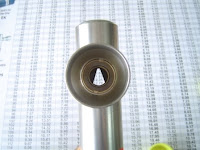The 3% difference.What makes Emerson’s moisture indicator better? Early detection. The HMI’s patented wafer dial uses a three-step gauge to detect moisture at 3% relative humidity (RH) – giving you plenty of time to make necessary adjustments before any damage is done. Ordinary indicators use a two-step paper gauge that only detects moisture at 10% RH – a level that is more than enough for corrosive acids to build up and totally destroy a system.
Designed for today. Made for tomorrow.The added moisture sensitivity of the HMI makes it ideal for nearly every refrigerant available – from HCFCs to new higher-pressure HFCs (including R-410A). In fact, the HMI is available with both ODF and SAE connections and is the only moisture indicator UL-approved to 680 psig. So even as your customers’ systems undergo mandated changes in the next few years, the HMI you install today will work with the refrigerants of tomorrow.
Built to last with a universal fit.The HMI has an airtight, corrosion-resistant brass body with no o-rings or knife-edge seals for guaranteed leak-free operation. Plus it is heat resistant, so you can braze without having to worry about damaging the internal wafer dial. For installation, the HMI features solid copper fittings for easy, universal replacement of any brand indicator. Saving you time, along with your reputation.
Now you see it. Now you know.Let’s face it, moisture indicators are almost always in dark areas with poor light. Which is why we gave the HMI a wide-angle, .71 square-inch viewing lens – by far the biggest in the industry. And with an easy-to-read tri-color-coded system, you’ll be able to read the dial even in low light.
Paper or plastic?The HMI wafer dial is a molded disk that is significantly more durable than ordinary paper indicators. And it is more sensitive to lower levels of moisture (3% versus 10% relative humidity). In fact, the color in a paper indicator can actually wash out under wet conditions. Plus paper indicators are highly susceptible to damage from brazing during installation.
Protect your reputation with the HVAC/R technology leader.When it comes to your HVAC/R systems, you have enough things to worry about. Your reputation shouldn’t be one of them. With Emerson’s HMI, you know your customers are getting a better indicator and you are getting a better warning system. After all, your reputation is worth it.
Lets look at the review from
http://www.achrnews.com.
Earlier indication. Better design. More reliability. The Emerson Climate Technologies Hermetic Moisture Indicator. Buy yours from our selected wholesalers.










